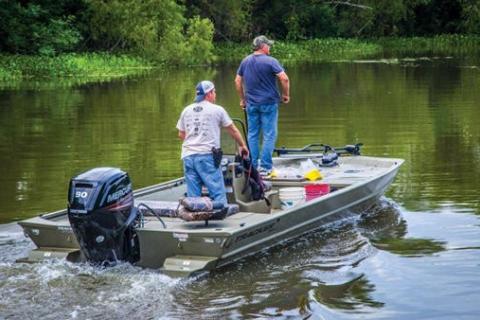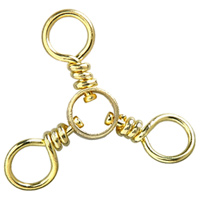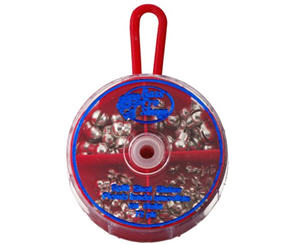
I'm fishing as the bell sinker telegraphed the contours of the rocky bottom. When I tapped bottom, I reeled up slightly to keep the sinker off bottom to prevent snags. Working the tiller motor, I slowly trolled along the breakline. Several feet behind the sinker, a blue and white minnowbait wiggled while I waited. It didn't take long for a hungry lake trout to hit trebles and after some impressive runs, the battle was over. The secret you ask — a simple, but versatile presentation known as a three-way rig.
What's a Three-way Fishing Rig?
 |
| A three-way swivel - the one thing that remains the constant in all the variations of the rig. |
The rig gets its name from using a three-way swivel like Bass Pro Shops Three-Way Brass Swivel — the one thing that remains constant in all the variations on how the rig can be tied. The three-way swivel is attached to the main line. Fishing leaders (of varying lengths) are then tied to the remaining two eyes. The bottom leader holds a weight to get the bait down, while the other leader holds the bait or a lure. Three-ways are a common rigging method to present live bait, either stationary in current areas as well as on a slow troll or a drift. Of course, this set up can also be used to troll minnowbaits, plugs or spoons. The rig can also go beyond the basic, which I'll discuss momentarily, and variations on a simple three-way rig are rampant in fishing circles.
Anglers Weigh Your Options
Part of the rig's beauty is its simplicity. Some anglers tie a light pound test line to the sinker leader, so that if it becomes snagged the lead will break free before the main line. This way snags only costs you a sinker instead of a lure and terminal tackle. Another trick is to pinch split shots on the bottom leader as shots simply slide off the line when snagged.
 |
| Bass Pro Shops Removable Split Shot Lead-Free Weight Assortment - 72-Pieces |
The bottom leader of the three-way should be weighted heavier than the other leader, which is the primary bait, but the bottom leader doesn't necessarily always hold a sinker. In fact, many savvy walleye anglers are replacing sinkers with jig heads, doubling the hooking potential of the presentation. Add a floating jig head tipped with a minnow to the other end and you've got two slightly different presentation styles to try and fool the fish with. Two baits will also let you experiment with different colors and types or live or artificial plastics until you find a pattern that produces. Deep water panfish anglers also use a similar method to double their hooking chances and opportunities to match the hatch.
Fishing the Rig
The way a three-way rig can be fished is only limited by your imagination and innovation as an angler. That said, this rig does excel in current areas as the added weight lets anglers control presentations in otherwise turbulent or unpredictable water. To provide some context and some examples of rigs you'll want to try, here are some different "three-waying" methods.
Shore Casting the Three-Way Rig
Both catfish and surf anglers use three-way rigs. Pyramid sinkers that hold in sand and mud are often tied to the bottom swivel to anchor bait offerings in tides. From mud-bottomed to snag-infested areas, catfish anglers use various sinker types to work deep pools and eddies for cats. In both cases, cut or live bait are tied to leaders of varying lengths. The rig's simplicity and its sinker-sacrifice-when-snagged design make it popular for shore bait fishing. Heavy sinkers give shore anglers the option of long casts to the depths, which is a good advantage to reach beyond the casting distance of lures like crankbaits or jigging spoons for example.
Trolling With the Three-Way Rig
The opening of this article alludes to one method three-way rigs can be used. In essence a three-way can serve as a frugal downrigger. The rig can be quite precise too if you've got a line counter on your fishing reel. It's also great to tie when you're trolling with three fishing rods in a basic boat that isn't equipped with trolling bells and whistles.
Lures can be run off each side of the boat and a third line, with a heavy sinker, can be dropped right behind the boat and out of the way of the other two lines. Fishing spoons and minnowbaits are prime lures to troll behind a three-way, just make sure you use a long enough leader to accommodate the bait's action so it doesn't tangle with the main or dropper line.
Drift Fishing a Three-Way Rig
Extremely popular with striper anglers, three-way rigs are deadly when tipped with live bait and used to drift areas. As mentioned earlier, walleye hunters also use this rig to present both a weighted and floating jig head in current situations. Heavy sinkers should be used to in current areas to prevent the lines from tangling. Also, whether trolling or drifting, lower the rig to the desired depth in stages and avoid opening the bail and allowing the rig to plummet to the bottom. The latter will almost guarantee a tangled rig, while the former will keep the various lines properly positioned in the water column at all times.
Anchoring the Boat to Fish
A properly weighted three-way rig can be deadly if anchoring in current areas to fish eddies, holes and breaks. The trick to this approach is to anchor the boat upstream of the area you want to fish and slowly lower a rig to the bottom. Next, lift the sinker off the bottom by raising the rod tip and let out a few feet of fishing line. If properly weighted, the rig will be pushed by the current slightly before the sinker touches the bottom again. Continue this method until the lure has worked the area directly behind you. Then reel in and drop the rig to either side or reposition the boat to cover more of the structure.
Hook Sets on a Three-Way Fishing Rig
Setting a fishing hook on a three-way rig is nothing fancy. Drop the rod slightly and then use a sweeping hook-set to pull in any slack line and drive the hooks home. Keep tight line on the fish at all times during the fight as any slack might cause the fish to shake the hook. This is especially true if you're using a heavy sinker at the other end of the swivel.
Although shadowed by new fishing gadgets and gizmos, the three-way rig is a time-tested presentation that delivers results. Applicable to a variety of fishing methods and different presentation styles, fishing this rig should be a skill in every angler's arsenal. If you're not already convinced to use this rig more often, try it a few times this season and I'm sure the fish will persuade you.
- 31388 views

